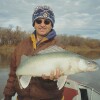Duck and goose hunters in North Dakota who have grown accustomed to skies full of birds over the past several years likely will have to lower their expectations this fall, a Devils Lake biologist predicts.
North Dakota’s regular waterfowl season opens Saturday, Sept. 25, for residents and Saturday, Oct. 2, for nonresidents.
“It’s going to be fair to poor,” predicts Mark Fisher, biologist for the U.S. Fish and Wildlife Service in Devils Lake. “That’s not to say there aren’t ducks. The ducks are probably going to be associated with big water – Lake Alice National Wildlife Refuge and Devils Lake itself.”
RELATED STORIES:
- Read more hunting stories in Northland Outdoors
- Read more fishing stories in Northland Outdoors
- Read more recreation stories in Northland Outdoors
The reason, in a word, boils down to drought. Not only across northeast North Dakota, but across the region in every direction.
ADVERTISEMENT
“I don’t know where the hotspots are anywhere, to tell you the truth,” Fisher said. “It’s going to be a tough season for duck hunting. It’s going to require a lot of driving and a lot of scouting, and that’s just the way it is.”
The North Dakota Game and Fish Department in early August said results from its annual mid-July duck production survey suggest this year’s fall flight of birds from North Dakota will be down 36% from last year and similar to fall flights in 1970, 1979 and 1994.

At the same time, brood counts during the July survey were down 49% from 2020 and 23% below the average since 1965. Game and Fish tallied an estimated 2.9 million ducks this past spring during the department’s 74th annual breeding duck survey, but the dry conditions even then suggested ducks would have poor production, Mike Szymanski, migratory game bird management supervisor for Game and Fish in Bismarck, said in a June news release.
Simply put, a hen duck that sees a wetland that’s dry or in poor condition will assume she can’t raise a brood and move on in search of better nesting cover, Szymanski said.

ADVERTISEMENT
According to Fisher, the Devils Lake biologist, the sorry state of wetlands in northeast North Dakota was readily apparent last spring when the U.S. Fish and Wildlife Service conducted its annual survey of small farmed wetlands in Ramsey, Benson, Tower and Cavalier counties.
The survey, which begins in mid-April and continues into mid-May, targets small wetlands on agricultural lands that typically are the first to have open water, Fisher said.
“We were looking at 3,000 small farmed wetlands, and I believe we found water in 15 of those 3,000,” Fisher said. “We didn’t expect to see a lot of water, we knew it was dry from last fall, very little snow in the winter and then coming into spring, but 15 of 3,000 was pathetic.
“And those small wetlands are really important for the birds.”
The Game and Fish Department’s July breeding duck survey showed an 80% decline in wetland abundance. Wetland conditions in northeast North Dakota have improved in some areas with recent rainfall, but the trend hasn’t resulted in more duck sightings, Fisher said.
“That was surprising to me,” Fisher said. “I would come to a wetland, and there wouldn’t be a single bird on it. That’s kind of a disappointment.”
Even giant Canada geese, normally abundant this time of year in the Lake Region and surrounding areas, have been harder to come by, he says, based on reports from North Dakota’s early Canada goose season.
“I know some guys that did pretty well, but nothing like it has been in the past,” Fisher said. “Even some of the farmers who have complained about goose depredation are asking, ‘Where are the geese?’
ADVERTISEMENT
“Canada goose numbers seem to be way down.”
Waterfowl abundance going into the opener seems more like what hunters often encounter two to three weeks after nonresidents can start hunting, when birds “kind of disappear,” Fisher said.
“You’d go to some areas where there’s good wetland complexes and there’s still water on the ground, and you’d look and go, ‘Man, there’s no ducks,’ ” Fisher said, describing what often happens after the nonresident influx. “That’s what I’m seeing – very, very few birds right now.”
The trend is a function of the drought, Fisher says.
“I know during the summer, during the peak of the breeding season, if you found wetlands with water, you found broods,” he said. “I can’t say they survived and fledged, but it did appear that we had production. I just don’t think we ever had a good number of birds in northeast North Dakota to begin with.
“And now, I don’t really know where they are.”
Hunters fortunate enough to find concentrations of ducks likely won’t have the areas to themselves unless they have exclusive access to private land that holds birds.
“It’s kind of like fishermen – when they see a couple of boats in one spot on the lake, then another boat shows up and next thing you know, there’s 10 boats in one spot,” Fisher said. “That concentration is probably going to bring a lot of people to the same spot to hunt as opposed to a normal year, when you can scatter out across the landscape and do pretty well.
ADVERTISEMENT
“And that, to me, makes the opportunities fair to poor for this waterfowl season.”
PULLOUT
RULES OF THE HUNT
Here’s a look at North Dakota’s waterfowl regulations for the 2021 hunting season:
Season opens for Saturday, Sept. 25, for residents; nonresidents may begin hunting waterfowl Saturday, Oct. 2.
Hunters may take six ducks per day with the following restrictions: five mallards of which two may be hens, three wood ducks, two redheads, two canvasbacks, one scaup and one pintail.
Hunters can take two additional blue-winged teal from Sept. 25 through Oct. 10.
The daily limit of five mergansers may include no more than two hooded mergansers. For ducks and mergansers, the possession limit is three times the daily limit.
The hunting season for Canada geese will close Dec. 18 in the Eastern Zone, Dec. 23 in the Western Zone and Dec. 31 in the Missouri River zone. The season for whitefronts closes Dec. 5, while the season on light geese is open through Dec. 31.
North Dakota Goose Hunting Zones by inforumdocs on Scribd
Shooting hours for all geese are one-half hour before sunrise to 2 p.m. each day.
Extended shooting hours for all geese are permitted from one-half hour before sunrise to sunset on Saturdays and Wednesdays through Nov. 27, and on Saturdays, Sundays and Wednesdays from Nov. 28 through the end of each season.
The bag limit for Canada geese during the regular season is eight daily and 24 in possession, except in the Missouri River Zone, where the limit is five daily and 15 in possession.
The daily limit on whitefronts is three with nine in possession, and light geese have a daily limit of 50 with no possession limit.
In accordance with state law, nonresidents are not allowed to hunt on North Dakota Game and Fish Department wildlife management areas or conservation PLOTS (Private Land Open To Sportsmen) areas from Oct. 9 through Oct. 15, with the exception of nonresidents hunting on PLOTS land they own.
Hunters who do not HIP certify when they buy a North Dakota license can add it through the Game and Fish website at gf.nd.gov or by calling (888) 634-4798 and recording the HIP number on their printed license. Those who registered to hunt North Dakota’s spring light goose season or August Management Take/Early September Canada goose season do not have to register with HIP again, as it is required in each state only once per year.
Hunters should refer to the North Dakota 2021-22 Hunting and Trapping Guide for further details on the waterfowl season.
– Herald staff report









